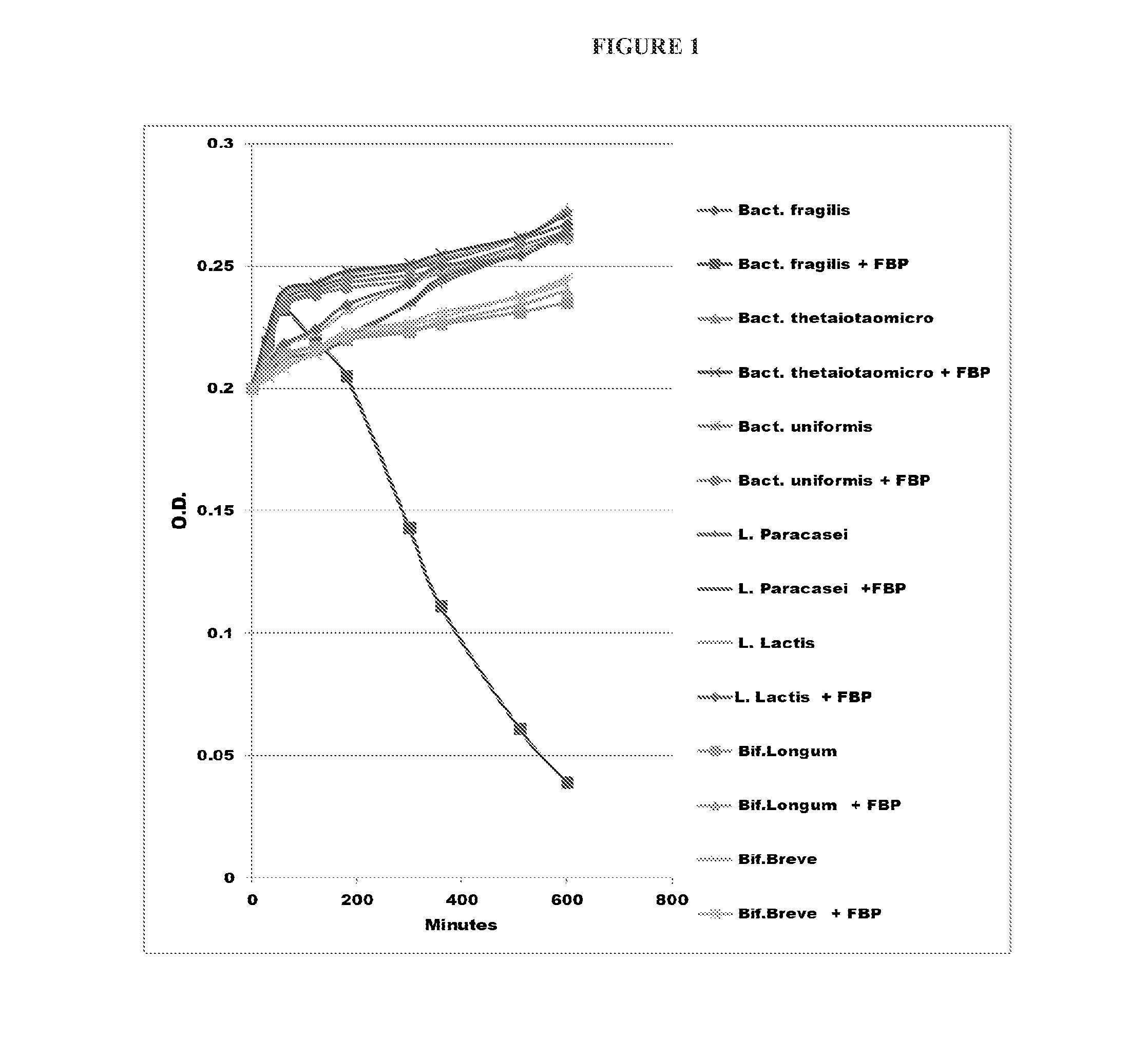Prebiotic compositions comprising one or more types of bacteriophage
- Summary
- Abstract
- Description
- Claims
- Application Information
AI Technical Summary
Benefits of technology
Problems solved by technology
Method used
Image
Examples
example 1
[0062]Bacteroides fragilis, Bacteroides uniformis, Bacteroides thetaiotaomicron and four strains of probiotics; Lactobacillus paracasei, Lactobacillus lactis, Bifidobacterium breve and Bifidobacterium longum (all Bacteroides strains purchased from ATCC) were tested in vitro. Frozen permanents of each bacterial strain were streaked for single colonies using Bile Esculin agar or nutrient agar warmed prior to use. For fresh inoculants, single bacterial cells were re-streaked on a Bile Esculin agar. The bacteriophage was propagated from bacteroides fragilis after 16-20 hours of bacterial growth, 16000 rpm cell clearing spin for 30 minutes and collection of the supernatant. Bacteriophage were concentrated using an Amicon Ultra-15,50 kDa cutoff concentrator, titers were determined by counting plaques from serial dilutions using the bacterial host strain. The Bacteroides fragilis bacteriophage (FBP) Cocktail was diluted to 1×106 PFU / mL.
[0063]Bacterial cells of several fresh colonies were i...
example 2
[0065]Bacteroides fragilis and four strains of probiotics; Lactobacillus paracasei, Lactobacillus lactis, Bifidobacterium breve and Bifidobacterium longum (all Bacteroides strains purchased from ATCC) were tested in vitro. Bacteroides is the dominate bacteria in the human gut, while most of the time, most of the strains of Bacteroides are symbiotic, certain bacteroides strains can be pathogenic. One of the main bacteroides strains known to cause pathogenicity in humans is bacteroides fragilis, which can take over the gastrointestinal tract robbing nutrients and crowding out good bacteria. For that reason, a prebiotic bacteriophage was chosen for its ability to quickly and efficiently lyse Bacteroides fragilis exclusively, providing good bacteria nutrients while maintaining a healthy natural gut flora. Frozen permanents of each bacterial strain were streaked for single colonies using Bile Esculin agar or nutrient agar warmed prior to use. For fresh inoculants, single bacterial cells ...
example 3
[0068]Bacterial cells of several fresh colonies were incubated in 50 mLs of nutrient broth (1% glucose) until the culture reached an optical density of 0.2. The bacteria was spun down and re-suspended in minimal media with 1% glucose, 1% inulin or 1% Isomalta-oligosaccharide as the sole carbon source. For anaerobic growth, 0.2 cultures were divided into flasks and purged with a 3-5 second shot of nitrogen, bacteriophage were quickly added at a multiplicity of infection (MOI) of 1 to one set and broth to the other for a control to each flask, sealed and put back on the shaker. Anaerobic samples were opened once, tested and discarded. Probiotic alone, with bacteroides, with bacteroides and FBP cocktail together and with FBP cocktail were mixed and allowed to grow for indicated time period in a shaker bath at 37° C. and pH 6.8. One milliliter samples were taken and diluted several times in Hardy Diagnostic phosphate buffer and plated on selected media for each type of probiotic and for...
PUM
 Login to View More
Login to View More Abstract
Description
Claims
Application Information
 Login to View More
Login to View More - R&D
- Intellectual Property
- Life Sciences
- Materials
- Tech Scout
- Unparalleled Data Quality
- Higher Quality Content
- 60% Fewer Hallucinations
Browse by: Latest US Patents, China's latest patents, Technical Efficacy Thesaurus, Application Domain, Technology Topic, Popular Technical Reports.
© 2025 PatSnap. All rights reserved.Legal|Privacy policy|Modern Slavery Act Transparency Statement|Sitemap|About US| Contact US: help@patsnap.com

